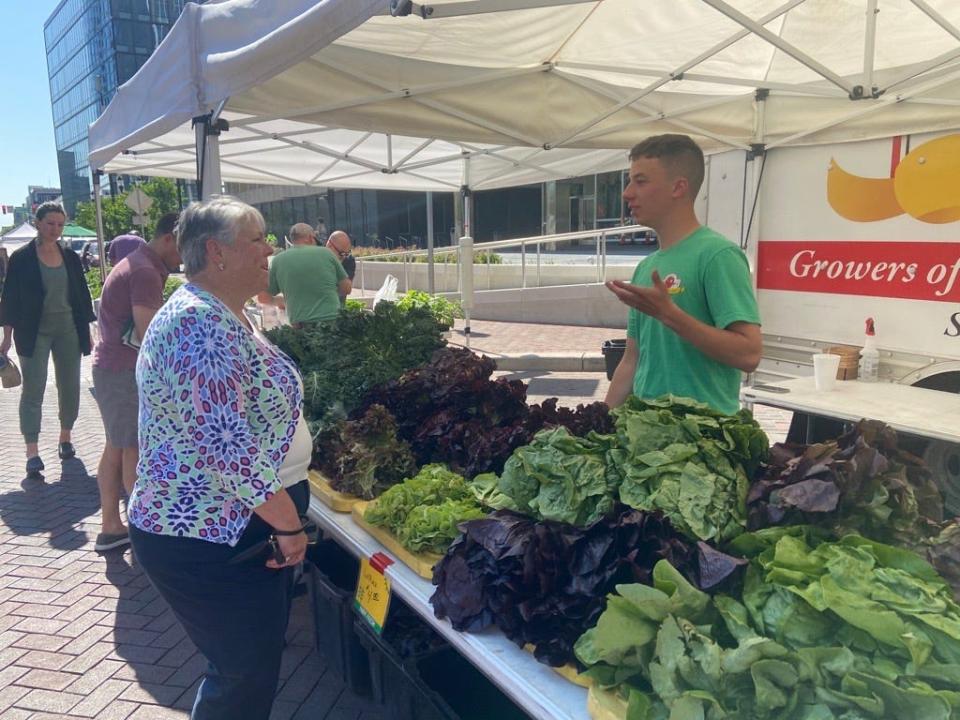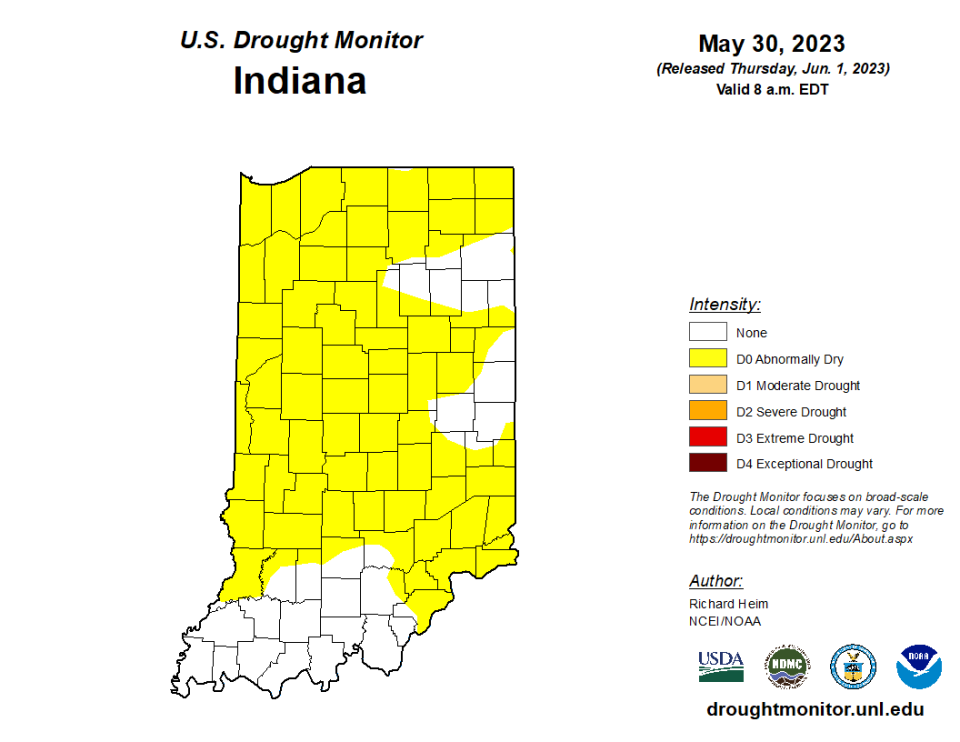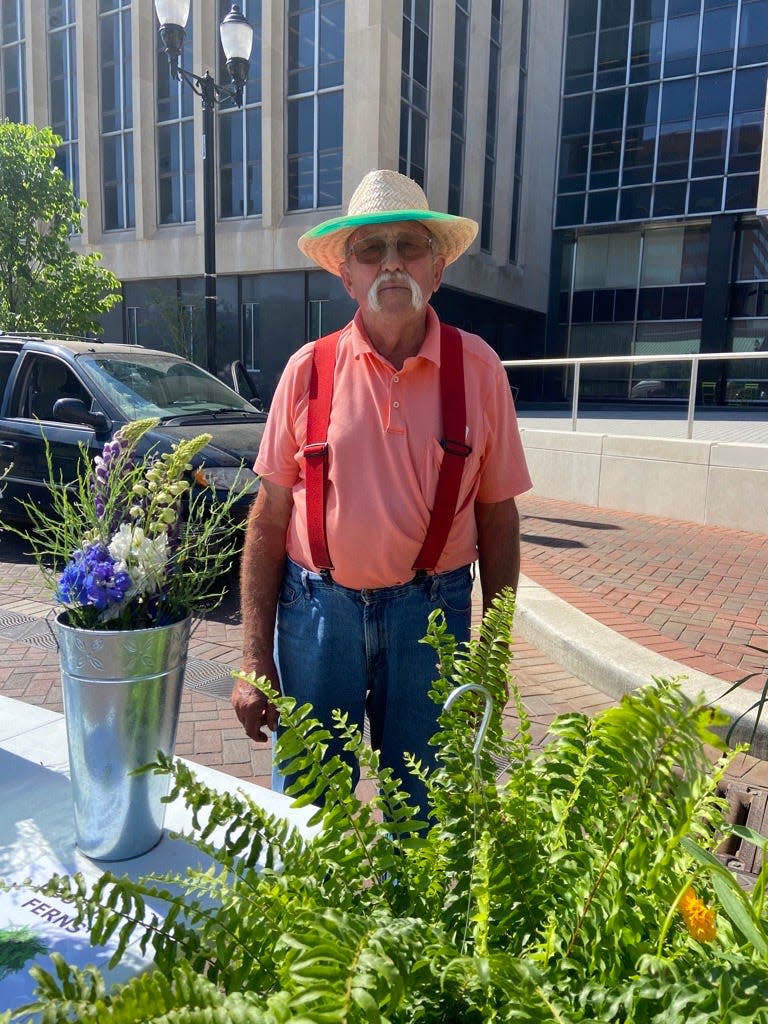Abnormally dry month for Indiana impacts farmers, but how severe is it?
Hose in hand, 19-year-old Thaddeus Goecker trails behind a Kubota Ranger, a small off-road utility vehicle driven by his older brother Lance — who he calls "the boss man." Lugging behind the vehicle are large tanks of water. As the brothers work their way up and down fields of tomatoes, broccoli, strawberries and melons, Goecker hoses down each and every one of the plants.

This isn't how they normally water their crops. It's hard labor that takes the farm workers a whole day. In fact, if rain comes regularly, they don't have to do it at all. But their Seymour-based family farm, called VanAntwerp's, hasn't seen rain in a while. And neither have many parts of the state, including Central Indiana.
Central Indiana climate: Knozone Action Day declared for June 2, 2023
Indiana has been abnormally dry this month. Meteorologists say a few weeks without precipitation can be typical, but a trend in dry conditions requires farmers to work overtime.
"It kind of gets us behind because we have other stuff that we need to be doing," Goecker said. "When we're planting new stuff, they need to be watered in every day. If we don't have the rain to water them in, we have to go do it ourselves out in the field."
Sneeze a lot? Allergies are rough now. Here are some tips to help.

How severe is the lack of rain?
A June 1 report from the U.S. Drought Monitor showed that most of the state is abnormally dry. The site says abnormally dry areas can experience stress on dryland crops and rangeland, brown lawns and gardens needing more water.

In May, the Indianapolis area saw rain levels at 2 inches below normal, meteorologist Andrew White said. The driest parts of the state, he said, are near Lafayette and southeast of Indianapolis, which is where Goecker's farm is located.
White said it's not unusual to see a two-week period without rain. In this case, high pressure staying in the area for a long time is causing the dryness — which is the same reason it's so hot.
More on the heat: 'Dome' over Indianapolis brings days of heat. What you need to know to stay safe.
But for farmers like Goecker, these two-plus weeks with no rain mean more work and higher bills. While the Southern Indiana farm has a pond and is hooked up to city water, it also has 11 greenhouses of tomato plants with automatic watering systems. When you factor in filling tanks of water during a dry period, it adds up.
Farmer: 'You're trying to outguess the weather'
Dean Fallis, 75, of West Point, Indiana, is facing a similar issue. His Central Indiana greenhouse and farm called Bloomers is west of Lafayette. He mainly produces herbs, flowers and vegetables.

His farm is in an abnormally dry area. When he faces a dry spell, he needs to adjust his morning schedule.
Over the past two weeks, he's been getting up at 5 a.m. to switch valves for his T-Tape irrigation system, which he said he's glad he added this year to make up for the lack of rain. This tape runs along the flower beds and gardens and, once water is pumped through it, expands and drips water onto the plants.
"The plants are growing, you gotta take care of 'em," Fallis said. "If you don't, they die. That's motivation enough."
In the farming business, fighting with the weather is the "same as always," he said.
"Either too much rain, not enough, the wind, frost," Fallis said. "You're trying to outguess the weather, which is getting tougher and tougher all the time because of climate change."
Scrub Hub: What are the risks of algal blooms and how does my family stay safe?
Is Indiana facing a drought? When will it rain again?
White, from the National Weather Service, said the next seven to 10 days don't look promising for rain. The only shot of precipitation, he said, is in forecasted pop-up afternoon showers that will still leave most of Indiana dry.
But Central Indiana isn't in a state of drought at the moment. The National Weather Service defines a drought as a "deficiency in precipitation over an extended period."
White said there are better chances for rain during the middle to end of June. He can't predict what parts of Indiana should expect that precipitation, though.
Meteorologist Jason Puma said while Indiana is heading toward a drier part of the year, it is difficult to forecast whether droughts will occur.
Watch this: Huge swarm of bees distracts Indy 500 crowd, but ultimately, 'if they sting, they sting'
Precautions should be taken during a dry spell
If you're outdoors grilling or making a fire, be cautious of any loose embers. The hot, dry weather increases the risk of grass catching fire.
Puma, from the National Weather Service, said he encourages residents to listen to their local governments for guidance on water usage.
You can also monitor how dry your location is by visiting droughtmonitor.unl.edu.
What's the weather forecast in Indianapolis?
Here's the Indianapolis forecast for the next few days from the National Weather Service, as of June 2:
Friday: Sunny and hot, with a high near 91. East northeast wind 5 to 8 mph.
Friday night: Mostly clear, with a low around 66. Northeast wind 6 to 8 mph.
Saturday: Mostly sunny and hot, with a high near 93. Northeast wind 6 to 10 mph.
Saturday night: Partly cloudy, with a low around 66. East northeast wind around 11 mph, with gusts as high as 18 mph.
Sunday: Mostly sunny, with a high near 89. Northeast wind around 11 mph.
Sunday night: Mostly clear, with a low around 61.
Monday: Sunny, with a high near 89.
Monday night: A 20 percent chance of showers after 9 p.m. Mostly cloudy, with a low around 64.
Tuesday: A 20 percent chance of showers. Partly sunny, with a high near 82.
Tuesday night: A 20 percent chance of showers before 9 p.m. Partly cloudy, with a low around 55.
Wednesday: Mostly sunny, with a high near 79.
Wednesday night: Mostly clear, with a low around 54.
Thursday: Sunny, with a high near 81.
This article originally appeared on Indianapolis Star: When will it rain again? Dry Indiana causes struggle for farmers

 money
money 